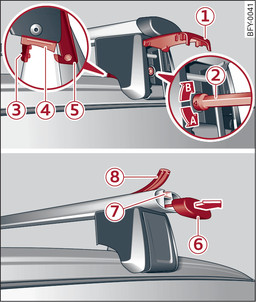|
Note the following points if you intend to carry loads on the roof:
- Only use roof carrier cross bars designed for your vehicle. The cross bars form the basic elements of a complete roof carrier system. Additional elements/carrier systems are needed in order to transport luggage and sports equipment. We recommend using roof carriers and additional elements from the range of Audi Genuine Accessories.
- The feet of the roof carrier cross bars must be attached at the points provided on the roof Fig. 85►.
- You should ensure that you do not exceed the maximum permitted axle loads, gross weight and roof load for your vehicle link►. The roof load limit applies to the combined weight of the roof carrier, the additional elements and the load itself. Please do not exceed the maximum carrying load of the carrier system you are using.
Attaching cross bars
Applies to: vehicles with factory-supplied cross bars
The roof carrier set consists of a front and a rear cross bar, a cover profile and a torque wrench. There are two holes on the inside of each roof railing for the rear cross bar. There are three holes at the front of the left roof railing and only two holes at the front of the right roof railing
Fig. 85►.
This is intended to prevent you from interchanging the front and rear cross bars.
- Open the cap -1- before fitting the cross bar.
- Using the torque wrench -2-, loosen the bolt on both sides in the direction -A- until you feel resistance. Please note that the arrow on the torque wrench should be exactly aligned with the arrow on the bolt.
- Clean the rubber pads -4- and the roof railing around the attachment points.
- Carefully position the cross bar on the roof railing in the area of the holes. Please ensure that the stickers are on the left side of the vehicle and that the printed arrow is pointing in the direction of travel.
- Insert the pins -3- in the holes. The claw fastener -5- must engage in the rim of the roof railing. Make sure that the rubber pads -4- are positioned flush on the roof railing.
- Use the torque wrench to tighten the bolt in direction -B-. Please note that the arrow on the torque wrench should be exactly aligned with the arrow on the bolt. The tightening torque required is 6 Nm.
- Repeat these steps for the other attachment points of the cross bars.
Attaching additional elements
Applies to: vehicles with factory-supplied cross bars
- To attach additional elements to the cross bars, pull off the cap -6-.
- Slide the elements into the T-section -7-.
- Secure the elements according to the assembly instructions supplied with the elements.
- Put the cap -6- back on.
Inserting cover profile
Applies to: vehicles with factory-supplied cross bars
- After you have attached the additional elements, seal the open parts of the T-section -7- using the cover profile -8-.
- If you do not wish to use any additional elements, seal the entire T-section -7- with the cover profile -8-.
- If necessary, the cover profile can be cut to the required length.
WARNING
- Note the fitting instructions provided by the manufacturer of the roof carrier system. If you do not secure the roof carrier system and roof load correctly, they can become separated from the vehicle and cause an accident.
- The use of a roof carrier system affects the vehicle s handling by shifting the centre of gravity and increasing susceptibility to cross winds – risk of accident! Take extra care when driving and adjust your speed accordingly. We recommend driving at a maximum speed of 130 km/h.
- Distribute the load evenly on the roof carrier system and make sure that it does not protrude over the width of the cross bars or exceed the maximum weight.
- All bolts and other connections of the roof carrier system must be checked before every journey and tightened if necessary. They should be checked again at regular intervals. Otherwise the roof carrier or additional elements can become loose and fall off - risk of accident!
CAUTION
- Any damage to the vehicle caused by the use of other types of roof carriers or incorrect installation will not be covered by the factory warranty. The roof carrier system must therefore be installed exactly according to the instructions provided.
- To avoid damage, remove the roof carrier system and any attached elements before driving into a car wash.
- Please take care that the boot lid and panorama sun roof* do not come into contact with the roof load when opened.
For the sake of the environment
The increased air resistance means that the vehicle uses more fuel. For this reason you should always take off the roof carrier when it is not in use.
Note
(Applies to vehicles with factory-supplied roof carrier bars: ) When the factory-supplied roof carrier cross bars are attached to the roof railings, the ESC is adapted to the change in the centre of gravity of the vehicle caused by any loading of the vehicle.


